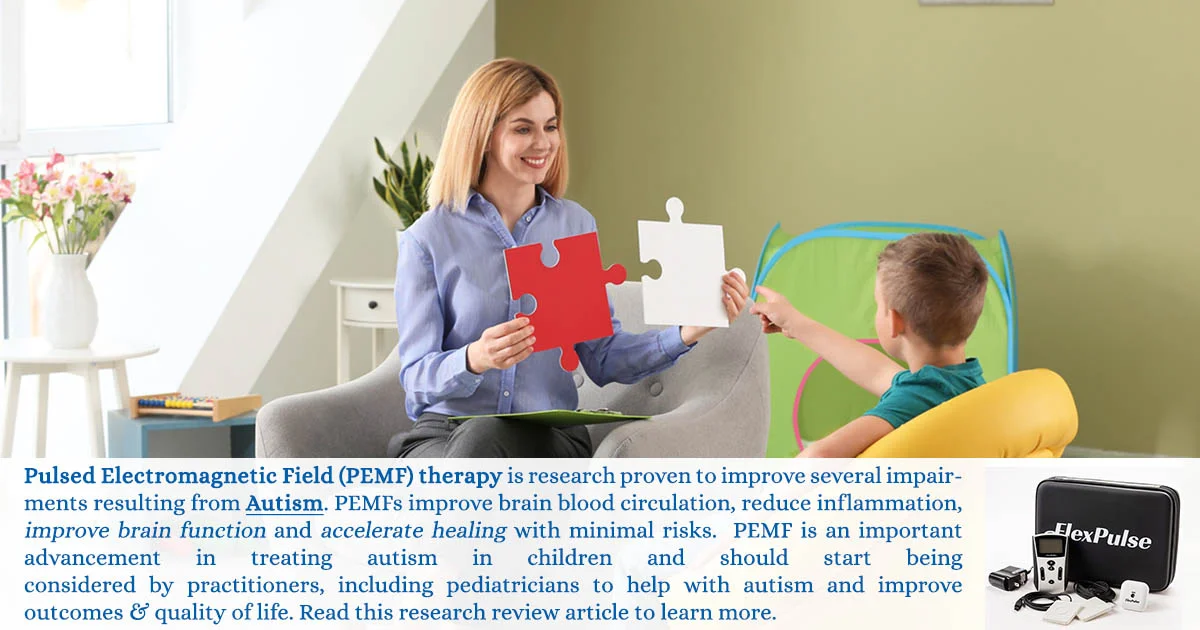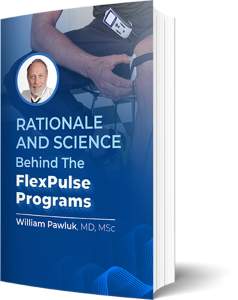Pulsed electromagnetic field (PEMF) therapy for Autism is research proven to improve several impairments resulting from the condition. PEMF is an important advancement in treating autism in children and should start being considered by practitioners, including pediatricians to help their patients with autism to improve outcomes and quality of life.

PEMF when applied to the head or brain is called transcranial magnetic stimulation (TMS). PEMF therapy, even with very high intensities applied to the brain, is safe, non-invasive and carries minimal risks. PEMF therapy for autism has been extensively studied and found to have no significant side-effects, other than occasional short-term headaches due to improved circulation. Pulsed electromagnetic fields improve brain blood circulation, reduce inflammation, improve brain function and accelerate healing. The same cannot be said about prescription medication for autism.
Unlike many other diseases that PEMF has been found effective for, Autism Spectrum Disorder (ASD) is a modern ailment. The CDC reports more than 100% increase in children with autism from 2000-2010 in the United States and that number is exponentially exploding. A genetic component has been found that limits the body’s ability to detoxify environmental factors. The combination of this genetic component in a significant percentage of the population, with an increased burden of environmental pollution in modern industrialized societies is likely contributing to this rapid increase in this disorder. These can include air, water and soil pollution, electro-pollution and processed food diets.
About 10% of autistic children also have Down syndrome or chromosomal disorders.
Scientists believe that autism is a mitochondrial dysfunction1 which reduces the energy capacity of neuronal cells. Oxidative stress contributes to worsening of autism spectrum disorder2. PEMF therapy improves mitochondrial function, oxygenation3, neuron conduction, production of neurotransmitters and reduction of inflammation from toxicity. The PEMF oxygenation study was conducted recently in 2018 and about 8 universities from France, Egypt, Germany and United States of America worked together on it.
Thus you would find that PEMF therapy for Autism Spectrum Disorder can have some immediate benefits. The fact that PEMF improves oxygenation is very well known and there are more studies that how PEMF helps cells in the bones4, nerves5 and tissues6.
Research on using pulsed electromagnetic field therapy for autism spectrum disorder
In 2010, University of Louisville School of Medicine scientists found substantial improvement in behaviour of autistic children who tried magnetic stimulation7. Irritability and repetitive behaviour decreased in these subjects. One young woman, with autism found her social skills greatly improved after brain stimulation using specialized tools. PEMF is a simpler solution, slower and safer than electrical brain implants or invasive magnetic stimulation.
Neuroscientists have been studying PEMF and magnetic stimulation methods for treating a variety of psychiatric disorders in children including ADHD, ASD, schizophrenia, Tourette’s syndrome8. The positive results indicate a great healing potential of using pulsed electromagnetic fields to reduce elevated cortical excitability and movement related electrophysiology9.
In 2014, an 18 week study with 2 control groups, showed remarkable improvement in behavior and cognition of autistic teenagers, using a 1 Hz magnetic field.10 Harvard medical scientists found that pulsed magnetic stimulation (PEMF) improves neuroplasticity and supports the safety and tolerability of using high-intensity theta burst magnetic stimulation.
2014, saw another double-blind study at Monash University, Australia where they also found that TMS decreases autism spectrum disorder related anxiety and social problems that such patients face.11
There are several more benefits of using PEMF therapy, from slowing down the aging process to improving sports performance, improving mood and treating depression.
As we can see, there is research evidence available now regarding effectiveness of PEMF therapy for autism. It should be possible to make a huge impact on autism and indeed several mental and neurological issues faced by special needs children using PEMF.
Research References
-
1.Lombard J. Autism: a mitochondrial disorder? Med Hypotheses. 1998;50(6):497-500. doi:10.1016/s0306-9877(98)90270-5
-
2.Chauhan A, Chauhan V. Oxidative stress in autism. Pathophysiology. 2006;13(3):171-181. doi:10.1016/j.pathophys.2006.05.007
-
3.Sherrard R, Morellini N, Jourdan N, et al. Low-intensity electromagnetic fields induce human cryptochrome to modulate intracellular reactive oxygen species. PLoS Biol. 2018;16(10):e2006229. doi:10.1371/journal.pbio.2006229
-
4.Ehnert S, Fentz A, Schreiner A, et al. Extremely low frequency pulsed electromagnetic fields cause antioxidative defense mechanisms in human osteoblasts via induction of •O2– and H2O2. Sci Rep. 2017;7(1):14544. doi:10.1038/s41598-017-14983-9
-
5.Hei W, Byun S, Kim J, et al. Effects of electromagnetic field (PEMF) exposure at different frequency and duration on the peripheral nerve regeneration: in vitro and in vivo study. Int J Neurosci. 2016;126(8):739-748. doi:10.3109/00207454.2015.1054032
-
6.Aragona S, Mereghetti G, Lotti J, Vosa A, Lotti T, Canavesi E. Electromagnetic field in control tissue regeneration, pelvic pain, neuro-inflammation and modulation of non-neuronal cells. J Biol Regul Homeost Agents. 2017;31(2 Suppl. 2):219-225. https://www.ncbi.nlm.nih.gov/pubmed/28702986.
-
7.Baruth JM, Casanova MF, El-Baz A, et al. Low-Frequency Repetitive Transcranial Magnetic Stimulation Modulates Evoked-Gamma Frequency Oscillations in Autism Spectrum Disorder. Journal of Neurotherapy. August 2010:179-194. doi:10.1080/10874208.2010.501500
-
8.Croarkin P, Wall C, Lee J. Applications of transcranial magnetic stimulation (TMS) in child and adolescent psychiatry. Int Rev Psychiatry. 2011;23(5):445-453. doi:10.3109/09540261.2011.623688
-
9.Enticott P, Rinehart N, Tonge B, Bradshaw J, Fitzgerald P. Repetitive transcranial magnetic stimulation (rTMS) improves movement-related cortical potentials in autism spectrum disorders. Brain Stimul. 2012;5(1):30-37. doi:10.1016/j.brs.2011.02.001
-
10.Sokhadze E, El-Baz A, Sears L, Opris I, Casanova M. rTMS neuromodulation improves electrocortical functional measures of information processing and behavioral responses in autism. Front Syst Neurosci. 2014;8:134. doi:10.3389/fnsys.2014.00134
-
11.Enticott P, Fitzgibbon B, Kennedy H, et al. A double-blind, randomized trial of deep repetitive transcranial magnetic stimulation (rTMS) for autism spectrum disorder. Brain Stimul. 2014;7(2):206-211. doi:10.1016/j.brs.2013.10.004

